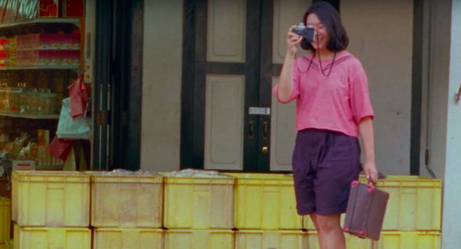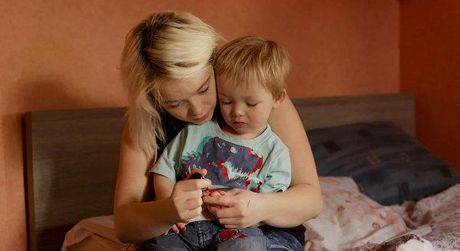
There’s a moment in the 2018 documentary Shirkers when narrator and filmmaker Sandi Tan says, “We were no longer magical kids who made a movie. We were just kids.” She’s referring to what happened after her friend and mentor, an American filmmaking instructor named Georges Cardona, disappeared in 1992, taking her movie with him. Tan, a young cinephile who was 19 at the time, had just created Singapore’s first indie road movie—also titled Shirkers—with friends Jasmine Ng (the film’s editor) and Sophia Siddique Harvey (the film’s executive producer). Cardona, who had been the film’s director, vanished from their lives, taking with him 70 canisters of 16mm film and effectively robbing Tan and her friends of their dreams. Shirkers is Tan’s debut feature and the bizarre tale of this betrayal, its rippling after-effects, and the strange twist her life took when the raw footage suddenly reappeared 20 years later.
“That’s how I make sense of the world, having to record it.”
Following Cardona’s disappearance, Tan became a film critic for Singapore’s largest newspaper, eventually moving to the U.S. where she continued to write screenplays and published a novel while trying to leave behind the heartbreak and humiliation of Shirkers. Then in 2011, she received an email that would change her life: Cardona had died and his widow had found 70 canisters of film labeled “Shirkers.” She shipped them to Tan, who kept them in her home but couldn’t bring herself to open them for another three years. When she finally did, she discovered that the sound was missing but that otherwise, they were in shockingly pristine condition. Thus began Shirkers’ reincarnation.
Scenes from the original film are woven into the documentary: they tell the story of S (played by Tan), a sixteen-year-old killer who travels around the island collecting people to join her in the next world. The images provide a vivid snapshot of Singapore on the verge of major transformation: in just one generation, the city-state went from being a lower income nation to a wealthy one, and Tan desperately wanted to capture its faces and places before everything changed. As a youth, Tan was a prolific letter writer and documentarian—instead of journaling, she wrote letters to friends, especially when she was working through intense experiences. “That’s how I make sense of the world, having to record it somehow,” she told me in a phone interview.

It’s this obsessive chronicling that lends Shirkers its punk rock charm. The documentary is composed of an impressive collage of interviews, original footage, letters, zines, drawings and photos from Tan’s youth. It is particularly refreshing to see such an unfiltered obsession with art and creativity from a young woman who lived in an environment that wasn’t conducive to creative output (Tan describes Singapore in the ‘90s as a consumerist society that did not prioritize artistic endeavours). She was truly groundbreaking in her drive and creations.
Part cultural reconstruction, part painful recollection and reconciliation, it’s no wonder the film has attained cult status, striking a chord with audiences around the world and winning the 2018 Sundance World Cinema Documentary Directing Award. Tan is a meticulous storyteller who manages to turn a personal story into a universal one: “For me, the most important point was to get the emotional and mental atmosphere correct. Once I got that right, I could take people on an incredible journey back and forth in time and space.”
It’s remarkable that Tan created the original Shirkers at a time when Singapore lacked a local film industry, funding programs and governmental support. Most Singaporeans didn’t understand what she was doing, yet she forged ahead with youthful optimism and brazen potential, capturing a nostalgia for the past and turning it into something fresh. That is, until Cardona’s betrayal and the abrupt moment when the magic was ripped away like a Band-Aid, forcing Tan (and the audience) to reckon with the exposed wound of growing up.

“It’s learning about human behaviour and letting that figure into your work because without experiencing a range of what people are like, you’re never going to produce work that is multidimensional.”
We will never know what direction Tan’s career might have taken had she not been robbed of this formative opportunity, but the filmmaker has made her peace with it. “I don’t think of [Cardona] as a villain. I think of him as a nemesis because, like a lot of mentors who both enable and thwart your dreams, he wasn’t all bad. He actually expanded my world—I have to give him that. And he was my best friend for a time. It’s a very complex thing.” While the mystery of what happened hangs over the film, it’s these interpersonal relationships—Tan’s prickly long-time friendship with Jasmine Ng, and her frenemy dynamic with Cardona—which truly drive the tension in Shirkers.
After the original film was digitized, Tan had to piece it all back together, resuscitating old friendships while weaving together a new story. She made Shirkers using small grants from the Sundance Institute and Cinereach. Similar to the plot and production of her original film, Tan collected a ragtag crew of people to help her, including editor/skateboarder Lucas Celler, composer Ishai Adar and Canadian cinematographer Iris Ng. Tan was not concerned with credentials when assembling her team, preferring instead to trust her intuition: “I pick them through my gut. I just love the discovery of new people that you don’t expect…. You bring them up and trust them on this thing, and everybody gets a huge bump. It becomes this hugely triumphant collaboration.”
Tan’s film beautifully exemplifies the virtue of patience and the idea that you can take something devastating—the hijacking of a dream, for instance—and turn it around. In reflecting on the process, Tan is philosophical. “Learn to do the mental jujitsu of turning something negative or unpleasant into something positive. It’s experience. It’s learning about human behaviour and letting that figure into your work because without experiencing a range of what people are like, you’re never going to produce work that is multidimensional.”





